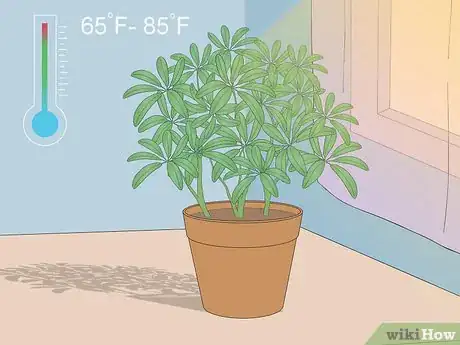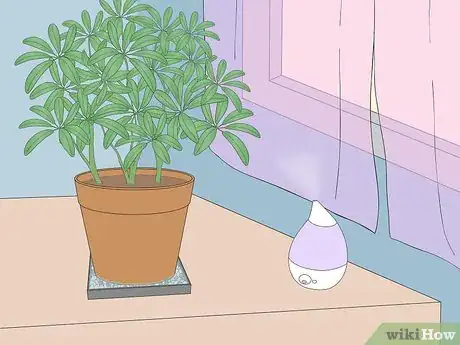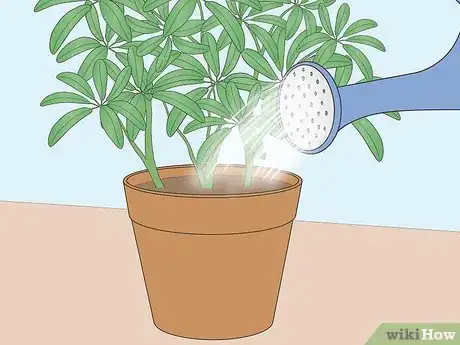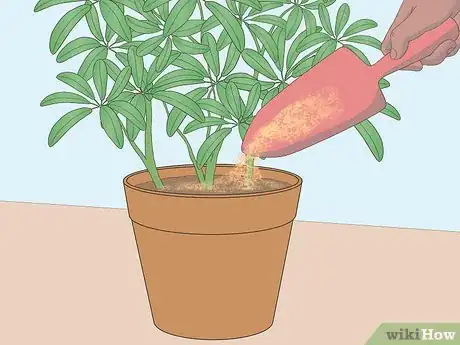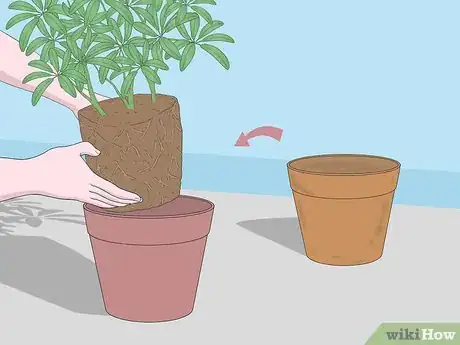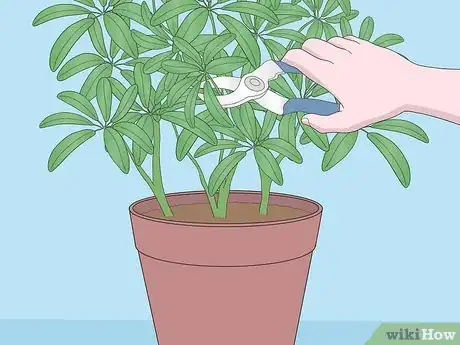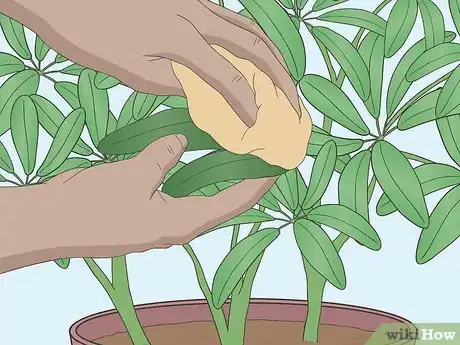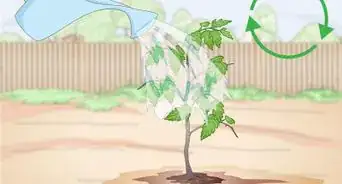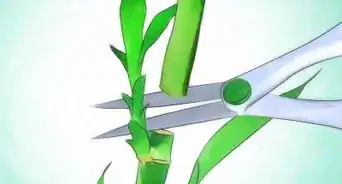wikiHow is a “wiki,” similar to Wikipedia, which means that many of our articles are co-written by multiple authors. To create this article, volunteer authors worked to edit and improve it over time.
wikiHow marks an article as reader-approved once it receives enough positive feedback. In this case, 100% of readers who voted found the article helpful, earning it our reader-approved status.
This article has been viewed 109,197 times.
Learn more...
Dwarf umbrella plants (Schefflera arboricola) are also known as dwarf umbrella trees, parasol plants, octopus trees and Schefflera. In their native Taiwan, they reach a mature height of 10 to 25 feet (3.0 to 7.6 m) but when grown as houseplants, they usually top out at 3 to 6 feet (0.9 to 1.8 m). This is not a difficult plant to care for, but it does have some requirements that must be met in order to keep it healthy.
Steps
Providing the Right Conditions
-
1Place the dwarf umbrella plant in a bright location, shielded from direct sunlight. The ideal setting for a dwarf umbrella plant is directly in front of an east, west, or south-facing window. Add a sheer curtain hanging between the plant and window to diffuse the direct sunlight.
- Another good location is right next to the window where the plant will get very bright but indirect sunlight. Direct sunlight through a window without the curtain to diffuse it, will scorch an umbrella plant’s leaves.
- When the umbrella plant is not getting enough light, the leaves will turn yellow and drop.[1]
-
2Keep the plant at temperatures between 65 and 85 degrees Fahrenheit. Average room temperatures of 65 to 75 °F (18 to 24 °C) are ideal, although the dwarf umbrella plant will do fine with temperatures up to 85 °F (29 °C).
- Do not allow the room temperature to drop below 60 °F (16 °C). The edges of the leaves will turn brown when the plant is exposed to temperatures that are too cold.[2]
- Additionally, do not place dwarf umbrella plants near heating and cooling vents or a drafty door.
Advertisement -
3Take the room's humidity levels into account. Average room humidity is usually fine for this plant, but if the house tends to get dry from heating or cooling, mist it each morning with room temperature water.[3]
- Maintain adequate humidity with a humidifier or a humidity tray, which is a shallow dish or pan filled with pebbles and water.
- Set the humidity tray below the umbrella plant. As the water evaporates from the tray, the humidity around the plant will increase.
-
4Water the plant when the soil becomes dry, using aged water. Water the dwarf umbrella plant with “aged” water when the potting soil is nearly dry or when the leaves begin to wilt.
- To age the water, fill the watering container a few days before watering the plant and leave it uncovered. This will allow the chlorine to dissipate and the water will be at room temperature when the plant is watered. This is a tropical plant that can be stressed by fresh, cold tap water.
- If the leaves become wrinkled, the plant is not getting enough water. If it is being overwatered, the leaves will turn black and drop.[4]
-
5Fertilize your dwarf umbrella plant every two weeks (except during winter). Give the dwarf umbrella plant a balanced houseplant fertilizer that is designed for foliage plants during the spring, summer and fall. A fertilizer ratio of 8-8-8 or 10-10-10 is fine.
- Use a liquid, water-soluble fertilizer mixed at half the rate recommended by the manufacturer. A common half-strength dilution rate is about ½ teaspoon of fertilizer per gallon of water, but this varies.[5]
- Pour the fertilizer solution evenly over the potting soil every two weeks immediately following a regular watering. Do not give the umbrella plant fertilizer before watering it as this could burn the roots.
- Fertilizer should not be given to the plant in the winter. The plant grows very slowly during the winter season and will not utilize the fertilizer.
Re-potting, Pruning and Pest Control
-
1Repot the dwarf umbrella plant when it seems to be growing slowly and the container is full of roots. Repot it into a container with drains holes in the bottom that is only one size larger than its current pot. Pour 1 to 2 inches (2.5 to 5.1 cm) of peat-based potting mix into the new container, turn the umbrella plant on its side and gently slide it out of its old container.
- If the roots are sticking to the side of the container, run a butter knife around the inside of the container to loosen them. Set the umbrella plant into the container and finish filling it with potting mix.
- Water it generously with aged water to help settle the soil around the roots.
-
2
-
3Keep the leaves clean to prevent spider mites. Wipe the leaves off with a damp sponge and clear, room-temperature water when they get dusty. Dirt and dust on the leaves block the light and provide a suitable environment for spider mites.
Community Q&A
-
QuestionThe leaves of my schefflera seem a pale green rather than a deep green.
 Community AnswerThis could either be a cultivar that just has lighter leaves, or your potting mix is not correct. You need a well draining mix but it needs plenty of organic matter. When you buy one, remove about half of the shipping mix, as it's mostly peat. Score the roots a bit with a knife and mix in a good organic soil like Dr Earth's "Pot of Gold". Don't forget bi-weekly fertilizer. Keep a five-gallon bucket outside with some netting over it to allow it to "age" but keep bugs and debris out. Use it to water the houseplants with.
Community AnswerThis could either be a cultivar that just has lighter leaves, or your potting mix is not correct. You need a well draining mix but it needs plenty of organic matter. When you buy one, remove about half of the shipping mix, as it's mostly peat. Score the roots a bit with a knife and mix in a good organic soil like Dr Earth's "Pot of Gold". Don't forget bi-weekly fertilizer. Keep a five-gallon bucket outside with some netting over it to allow it to "age" but keep bugs and debris out. Use it to water the houseplants with. -
QuestionCan I mix Miracle Grow with water for my fertilizer?
 Community AnswerYes, but be very careful not to over-fertilize. Use a 1/4 solution, or about 1/2 teaspoon or less per full gallon of water. I like to 'age' this water, too. Mix the fertilizer with water and leave in a place where it will reach room temperature for a day or two. Resting further removes all traces of chlorine.
Community AnswerYes, but be very careful not to over-fertilize. Use a 1/4 solution, or about 1/2 teaspoon or less per full gallon of water. I like to 'age' this water, too. Mix the fertilizer with water and leave in a place where it will reach room temperature for a day or two. Resting further removes all traces of chlorine. -
QuestionWhat is the reason that the plant on my patio has leaves wilting and turning black?
 Community AnswerDirect sunlight can be harmful to the schefflera plant. Try shaded indirect sunlight instead.
Community AnswerDirect sunlight can be harmful to the schefflera plant. Try shaded indirect sunlight instead.
References
- ↑ http://www.houseplantsforyou.com/dwarf-umbrella-tree/
- ↑ http://www.missouribotanicalgarden.org/PlantFinder/PlantFinderDetails.aspx?kempercode=b636
- ↑ http://www.missouribotanicalgarden.org/PlantFinder/PlantFinderDetails.aspx?kempercode=b636
- ↑ https://www.epicgardening.com/umbrella-tree-care/
- ↑ http://www.clemson.edu/extension/hgic/plants/indoor/foliage/hgic1511.html
- ↑ https://hgic.clemson.edu/factsheet/schefflera-2/
About This Article
Dwarf umbrella plants are relatively easy to care for, but you’ll need to provide the right conditions for it to flourish. Keep your plant in a bright spot, shielded from direct sunlight. For example, you could put it in front of an east, west, or south-facing window. Don’t put your plant near heating or cooling vents, and try to have an average room temperature between 65 and 75 degrees Fahrenheit. When the soil becomes dry or the leaves begin to wilt, water the plant with water that’s been sitting for a few days to let the chlorine dissipate and the temperature regulate. Give your plant a balanced houseplant fertilizer every 2 weeks during the spring, summer, and fall to help it grow. To learn how to prune your umbrella plant, keep reading!

